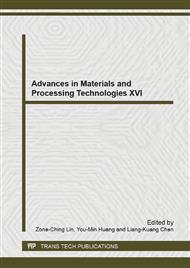[1]
L.M. Tian, L.Q. Ren, X. Jiang, G.R. Zhao, Z.H. Qian. The Study of Drag Reduction around Bodies of Revolution using Bionic Non-smooth Surfaces. Proceedings of the international conference of bionic engineering-ICBE'06, 303-309.
DOI: 10.1016/s1672-6529(07)60022-5
Google Scholar
[2]
SONG Bao-wei, LIU Guan-shan, HU Hai-bao. Simulation study on surface drag-reduction with V-size traveling wave of different aspect ratios. Computer Engineering and plications. 2009. 45(32): 222—224.
Google Scholar
[3]
S. XU, D. REMPFER, J. LUMLEY. Turbulence over a compliant surface: numerical simulation and analysis. J. Fluid Mech. (2003), vol. 478, p.11–34. 2003 Cambridge University Press.
DOI: 10.1017/s0022112002003324
Google Scholar
[4]
T. LEE, M. FISHER W. H. SCHWARZ. Investigation of the stable interaction of a passive compliant surface with a turbulent boundary layer. J. Fluid Mech. (1993), vol. 257, p.373401.
DOI: 10.1017/s002211209300312x
Google Scholar
[5]
D. Mazzoni. An efficient approximation for the vibro-acoustic response of a turbulent boundary layer excited panel. J. Journal of Sound and Vibration 264 (2003) 951–971.
DOI: 10.1016/s0022-460x(02)01191-4
Google Scholar
[6]
Robert L. Ash. ON THE THEORY OF COMPLIANT WALL DRAG REDUCTION IN TURBULENT BOUNDARY LAYERS. NATIONAL AERONAUTICS AND SPACE ADMINISTRATION • WASHINGTON, D. C. • APRIL (1974).
Google Scholar
[7]
Mohamed Gad-el-Hak. Compliant coatings: The simpler alternative. Experimental Thermal and Fluid Science 16 (1998) 141-156.
DOI: 10.1016/s0894-1777(97)10006-1
Google Scholar
[8]
A. J. COOPER PETER W. CARPENTER. The stability of rotating-disc boundary-layer flow over a compliant wall. J. Fluid Mech. (1997), vol. 350, pp.231-259. Printed in the United Kingdom.
DOI: 10.1017/s0022112097006976
Google Scholar
[9]
GUO Xiao-juan, PAN Guang, DUAN Zhao-yi. Drag-reduction Characteristics of Turbulent Boundary Layer Flow over the Variform Traveling Wave Surface. J. Fire Control and Command Control. 8(2008)13-15.
Google Scholar
[10]
K. -S. Choi, X. Yang, B. R. Clayton, E. J. Glover, M. Atlar,B. N. Semenov, V. M. Kulik. Turbulent drag reduction using compliant surfaces. Proc. R. Soc. Lond. A (1997), 2229-2240.
DOI: 10.1098/rspa.1997.0119
Google Scholar
[11]
ZHU Qi-feng, SONG Bao-wei, HUANG Qiao-gao. Research on Method for Optimization Design of Riblets Angle Based on CFD Techniques. J. Journals of Ship Mechnics. 9(2012), 1016-1022.
Google Scholar
[12]
Mohamed Gad-el-Hak. Compliant coatings for drag reduction. J. Progress in Aerospace Sciences 38 (2002) 77–99.
DOI: 10.1016/s0376-0421(01)00020-3
Google Scholar
[13]
PAN Guang, GUO Xiao-juan, HU Hai-bao. Numerical Simulation of Semicircular Traveling Wave Surface and Study on Its Drag-Reduction Mechanism. J. Journal of System Simulation. 11(2006), 3073-3094.
Google Scholar
[14]
SONG Juan-Juan, XU Yu, HUANG Chen-Wu, etc. Numerical Simulation of Drag Reduction by Non-Smooth Surfaces in Turbulent Flow. JOURNAL OF ENGINEERING THERMOPHYSICS. 32(2011), 771-774.
Google Scholar


